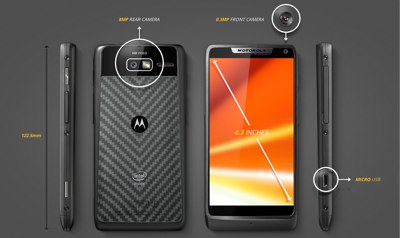To the casual shopper, the Razr i smartphone announced by Motorola yesterday might seem much the same as any other Android 4.0 (“Ice Cream Sandwich”) phone. Yet, the 4.3-inch Razr i is also the first smartphone with a 2GHz clock rate, and the first Intel “Medfield” Atom-based phone to launch in multiple markets.
More significantly, the battery is claimed to last much longer than on earlier phones featuring Medfield chips. Battery life has long been a challenge for Atom-based mobile devices, but if Motorola’s claims are true, the issue may be moot. The Razr i and its 2000mAh battery is claimed to offer up to 20 hours of use — almost as long as the long-lasting Razr Maxx and 40 percent longer than the iPhone 4S.
 The Razr i is almost identical to Verizon’s ARM-based Razr M, which was announced earlier this month with the Razr HD and 4.7-inch Droid Razr Maxx HD. The new Razr models are the first Motorola devices to be developed under Google’s oversight. The Razr i has the added distinction of being the first product collaboration in Google’s multi-year Android pact with Intel.
The Razr i is almost identical to Verizon’s ARM-based Razr M, which was announced earlier this month with the Razr HD and 4.7-inch Droid Razr Maxx HD. The new Razr models are the first Motorola devices to be developed under Google’s oversight. The Razr i has the added distinction of being the first product collaboration in Google’s multi-year Android pact with Intel.
Despite Google involvement, Android 4.1 (“Jelly Bean”) will not be on tap when the Razr i ships in early October in Argentina, Brazil, France, Germany, Mexico and the U.K. Like most ICS devices however, it’s slated for a downloadable upgrade. Clove Technology has opened pre-orders in the U.K. for the unlocked phone at 285 Pounds, or 342 Pounds ($556) with tax.
Feature Upgrades
The 4.3-inch display on the Razr i and Razr M are limited to qHD (960 x 540) resolution, but they feature eye-popping Super AMOLED Advanced technology. The splash-resistant, Kevlar-reinforced screen extends almost to the edges of the aluminum-framed device, making the phone narrower than most 4.3-inch phones.
The 8.9mm profile is thicker than that of the original 7.1mm Droid Razr, but bests the 8.99mm Razr Maxx, and there’s no more cheating with a fatter hump on one end. The Razr i’s 8-megapixel camera is said to be loadable in one second and available with a 10-shot-per-second capability.
The Google influence can be seen in features like a Circles widget and an NFC (near field communication) radio. Like Google-branded Nexus devices, the Razr i appears to lack UI overlays or bloatware.
2GHz Medfield for Fast Web Browsing
The 2GHz version of the Medfield Atom Z2460 appears to be a winner, according to early benchmarks from Engadget. The Razr i is significantly faster than the ZTE Grand X IN, which ships in Europe later this month with a 1.6GHz Medfield. In fact, the difference is more pronounced than the clock rate alone would indicate, suggesting more extensive optimization with ICS, and perhaps better optimization for Medfield. Before we start freaking out about Googarola run amok, note that Nexus devices from other vendors have enjoyed similar Google perks.
Note that the Razr M with its dual-core 1.5GHz Snapdragon processor is still somewhat faster than the Razr i on most tests, according to Engadget. The 2GHz Medfield has only one core, and Intel still has a way to go before Medfield is fully optimized for Android. Notably, however, the Razr i wins by an almost two-to-one margin on the all-important SunSpider benchmark of the Chrome web browser.
It’s unlikely the 3G-only Razr i will re-emerge in a 4G LTE version for the U.S. In the first half of 2013, however, Intel plans to ship a faster, dual-core Z2580 processor that supports LTE, as well as a stripped down Z2000.
Sixth Time a Charm
When it ships in October, the Razr i will be the sixth Medfield-based Android phone to reach market. It’s the first, however, to move beyond Intel’s original, 4-inch, 1.6GHz Medfield reference design. In April, Lava launched the India-targeted Xolo X900, which according to Anandtech is impressive in single-task performance, and fairly competitive on other benchmarks. Battery life, however, was mediocre.
The Xolo X900 was followed by Lenovo’s China-targeted LePhone K800 and Orange’s San Diego, which launched in the U.K. in June. Last month, Russian carrier MegaFon announced a similar MegaFon Mint. The aforementioned ZTE Grand X IN, deviates slightly from reference by moving to a curvier, 4.3-inch design.
While Intel is primarily focusing its phone strategy on Android, on tablets it is collaborating with Microsoft, optimizing its upcoming Clover Trail processor for Windows 8 based Surface tablets. On Sept. 17, Intel modified its statement from last week that Clover Trail would not support Linux or Android due to a lack of power optimization. Intel now says it is porting Android to Clover Trail after all, but that a version of the processor that is optimized for Linux and Android tablets is still in the planning stages. AMD’s rival Hondo processor will also initially focus on Windows 8 before expanding to provide optimization for Linux and Android, says the company.

